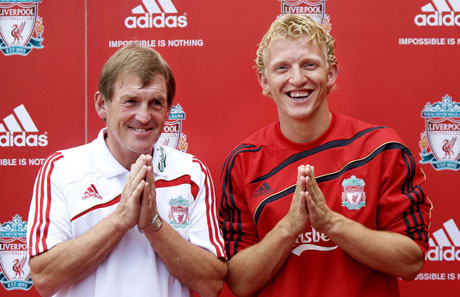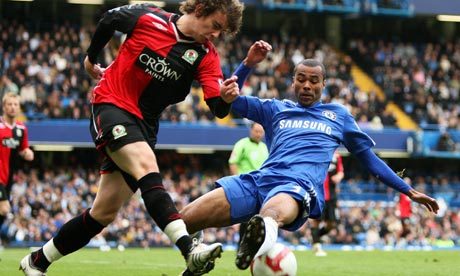-
Recent Articles
The Midfielder as Centerback
 Marcelo Biesla and Josep Guardiola are both managers who play a very high line with their respective sides and who both demand that all players be technically proficient with the ball. Part of playing...
Marcelo Biesla and Josep Guardiola are both managers who play a very high line with their respective sides and who both demand that all players be technically proficient with the ball. Part of playing...Understanding the 4-4-2 Diamond
DEFENCE Despite the fact that there are four ways to play a diamond formation on FM, the differences between them are few and usually subtle. As a starting point, one thing each of them do have...3 at the back and the 4-4-2 Diamond
 Last week Chelsea v Liverpool became the biggest tactical talking point of the season. Liverpool revived the the 3 man defence that Kenny debuted against Stoke. While with the introduction of Torres for £50m...
Last week Chelsea v Liverpool became the biggest tactical talking point of the season. Liverpool revived the the 3 man defence that Kenny debuted against Stoke. While with the introduction of Torres for £50m...How To Set Up A Back Four
 Last year, I wrote a guide about how to play a simple 4-4-2. One of the major components of that is the back four. In fact, most modern formations build upon four defenders; two full backs and two centre...
Last year, I wrote a guide about how to play a simple 4-4-2. One of the major components of that is the back four. In fact, most modern formations build upon four defenders; two full backs and two centre...Building Your Defence: Full Backs
 The modern full back is quickly becoming one of the most important players on the team sheet, infact even back in the days of Brian Clough, fat ed' argued that because of the space these players get in the final...
The modern full back is quickly becoming one of the most important players on the team sheet, infact even back in the days of Brian Clough, fat ed' argued that because of the space these players get in the final...
JOIN 12,748 READERS - SUBSCRIBE NOW TO OUR FOOTBALL MANAGER NEWSLETTER
Get the latest FM news & best community content delivered directly to your e-mail inbox!
Tactical Theorems & Frameworks ’09: Framework Adaptation
Written by: Richard Claydon
Category: Formations
Posted on: November 23, 2008
November 23, 2008
Framework Adaptation
Although this section links very closely to the frameworks section, it also refers to Match Strategy Theories (pages 32-34). To get the most out of this section, it might be best to familiarise yourself with the basics of these strategic ideas.
Defensive Line
Getting the defensive line right is fundamental to a team being able to defend effectively. This section discusses the various elements a manager needs to consider when setting up his back line.
Relation to Mentality System
The most important setting for the defensive line relates to the mentality system. The back line must be in contact with its midfield at all times. If it isn’t, opposition forwards will constantly exploit the gap between the deepest midfielder and the central defenders. This will lead to the team being vulnerable to long shots (as the forwards have plenty of time and space to set themselves) plus a series of desperate last-ditch tackles resulting in bookings and dangerous free kicks. A solid defence needs to have at least one defensively minded central midfielder harassing attacking moves before they reach the defensive line.
To ensure the above doesn’t happen, the defensive line must be linked to the mentality structure. As a rough guide, the non-floating Support players’ mentality instructions determine the most desirable setting for the defensive line. Linking the defensive line to the mentality system ensures the back four remains in contact with the midfield and the team plays as a unit rather than separate attacking and defensive forces.
Relation to Opposition Formation
Whilst it is always important to keep the above in mind when setting a default defensive line, a good manager will also take into account the opposing formation he is facing. A formation that is narrow and multi-strata (e.g. wingless 4-1-2-1-2, wingless 4-3-1-2) generates a lot of chances through the AMC. Increasing the d-line reduces the space in which the opposing AMC can operate and limits his effectiveness. As there are no wingers, it is difficult for such a formation to spread the play wide into space, so utilising the high d-line against this type of formation often results in passing chances drying up and loss of possession for the opposition.
If the opposing side is playing with a very defensive formation, it is often worthwhile deepening the defensive line. Defensively structured formations (4-1-4-1, 4-5-1) typically have no midfielders supporting the forward and rely on direct/long balls down the flanks/over the top to create counter-attacking chances. A deeper defensive line limits the chances of such balls being successful and often isolates the forwards when they do get possession, as they have nobody supporting the move and quickly find themselves surrounded by opposing defenders and midfielders. This often results in the defending team winning possession back in a dangerous area and being able to launch a counter attack before the opposing defence has had time to regroup.
Relation to Player Attributes
It is important to be aware of both your own and opposing player attributes when setting your defensive line prior to each match. If your central defenders are on the slow side a deeper defensive line is going to be a safer bet. This will need to be protected with a more defensive mentality system, which collapses the central midfield into the pocket and makes it difficult for fast forwards to run at or behind the back line. In contrast, if the back line is very athletic then a higher defensive line with more aggressive closing down will put opposition strikers under pressure the instant they get the ball. Learning how high a defensive line your starting defenders can cope with will be hugely beneficial when setting defensive strategies for different opponents.
Relation to Pitch Size
If the pitch is on the short side, a very high defensive line might be problematic for your team, no matter how athletic your back four. With less ground to cover, a breaking forward might well be able to stay ahead of a chasing defender long enough to get a clear shot on goal. On a longer pitch, the defenders will have more time to cover the break and snuff out the chance. In contrast, a high defensive line on a short pitch may increase the chances of your defenders being caught in possession by a heavily pressing front line, especially if you are playing a low tempo, short passing game. On a longer pitch, the opposite applies. A low defensive line offers an increased amount of exploitable space in front of the back four, which could cause problems against quick and skilful attacks. It also requires defenders to have better passing attributes as longer passes more easily go astray, leading to intercepted balls in dangerous positions. Taking careful consideration of your defenders’ attributes when deciding your pitch size is a major step towards building a defensive home fortress.
Additional Settings
The Nike Defence: relies on an athletic player sweeping balls behind a more destructive blocker and thus requires a higher d-line.
The Libero Defence: relies on a world-class ball playing defender being able to step out of the line and join attacks, leaving a defensively minded midfielder and central defender as cover. To do this effectively you will have to play a lower d-line to open up the space for the Libero to move into.
Width
Relation to Match Strategy
In general, aggressive strategies require width. Attacking and controlling strategies need to open up space in the final third in order for their creative players to do damage. If the opposition is trying to shut-up shop, maximise width to try and break down the packed defence. If the opposition is trying to counter, then a slightly narrower formation prevents your defence from having to cover too much ground when the opposition does manage to break. A standard match strategy offers defensive solidity with some attacking flair and is best employed with medium width. A defensive strategy aims to reduce space in the defensive third and is narrower. A shut-up shop strategy aims to put as many bodies between the goal and ball as possible and is very narrow (see pages 32-34 for further information on the above match strategies).
Relation to Pitch Size
Although the above is very important in managing an overall match strategy, pitch size also needs to be taken into consideration. With a very wide pitch, players can easily find space and defending is generally tougher. Narrowing the formation ensures that the defence has less ground to cover when defending quick breaks without unduly compromising attacking options. When playing on a very small pitch, space is at a premium and therefore you will need your team to play wider than usual to have any hope of capitalising on attacks. A well-designed defence is still effective on a small pitch even when playing on the counter with maximum width. Think about what type of football you want to play at home prior to setting your pitch dimensions.
Tempo
Relation to Match Strategy
An attacking strategy aims to keep constant pressure on the opposition in order to stop them having time to break forward and counter. As such, it is generally pretty fast paced. On the other hand, a control strategy works on the assumption the opposition won’t even try to attack so aims to keep possession and slowly prise open gaps in the defence. Thus, a slower tempo is more suitable. For standard tactics, the manager can use the tempo instruction far more intuitively, cranking it up when the team seems to be on top and slowing it down when they are struggling to keep hold of the ball. Defensive strategies are very dependent on player quality. If you have a side that can play keep ball prior to releasing quick counters, then a slow tempo is fine. If, however, your players are prone to losing possession easily, play at a quicker pace to try and disrupt the opposition and take advantage of their mistakes. Quick tempo with a defensive strategy will result in a lot of ball for your opposition, but less likelihood of one of your players being caught in possession in a dangerous position. You’ll need to have good defenders to pull this off. Slowing it down can often lead to a lot of possession, but you will need to have players you can trust to keep the ball under pressure.
Relation to Pitch Size
Pitch size is very important when it comes to determining tempo. A fast paced strategy is excellent for a small pitch whereas a slower tempo is better for large ones. Passing and closing down at pace on a small pitch reduces the chance of a player losing the ball in a tight spot whilst increases the opportunities for your midfielders and attackers winning balls in dangerous areas. As the pitch is small, players have to cover less ground and are therefore less likely to run out of steam. Fast tempo play on a huge pitch leads to a greater chance of a hurried, misplaced and intercepted pass. Furthermore, the team will tire and make mistakes during the latter stages of a match. Look to slow things down, keep the ball and force the opposition to do all the chasing. Think about what type of football you want to play at home prior to setting your pitch dimensions.
About The Author: Richard Claydon
Tactical theory has evolved massively down the years, from Diablo-style beat-’em-alls through Cleon’s era to the present day systems inspired by wwfan’s theories. Richard is considered to be the authority on FM tactics, and was approached by Sports Interactive to help write the new tactical interface in Football Manager Live and Football Manager 2010.
Download Our Tactical Theorems '10 eBook Absolutely Free

Presenting the most comprehensive tactic design and match strategy guide to the Football Manager series ever created!
Written by FM match engine beta testers, it's 60+ pages of easy-to-read concepts and ideologies for getting your team playing exactly how you want each match! It's been downloaded over 100,000+ times to date!
Find out more information about our tactical eBook
and download Tactical Theorems '10 right now!
Written by FM match engine beta testers, it's 60+ pages of easy-to-read concepts and ideologies for getting your team playing exactly how you want each match! It's been downloaded over 100,000+ times to date!
and download Tactical Theorems '10 right now!



